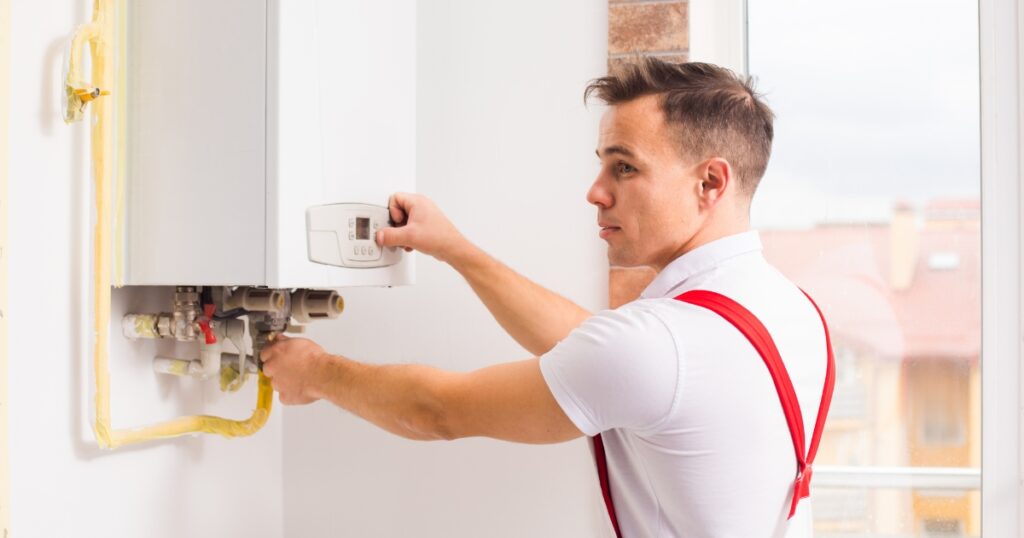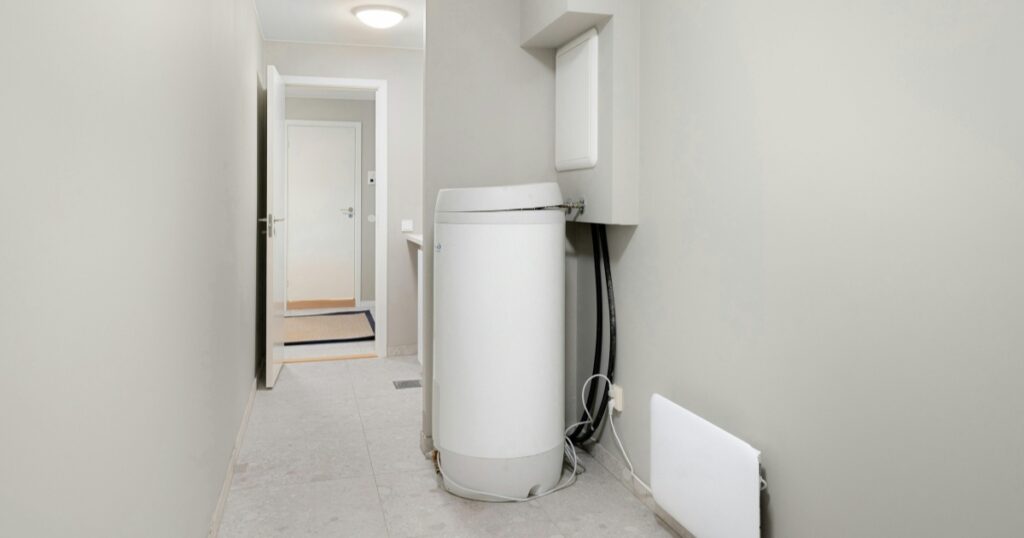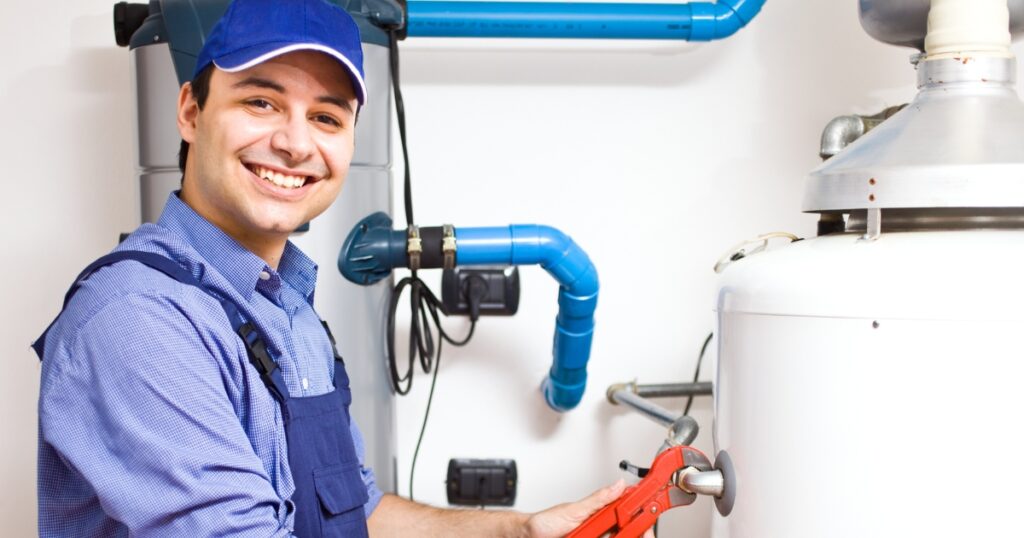We get it. There’s nothing quite as frustrating as copping a cold shower when you were banking on a toasty one. We’ve meticulously researched and put together this robust guide to help you troubleshoot those niggling hot water system problems.
Time to roll up your sleeves – solving these hot water headaches might just be simpler than holding onto the footy after a few frothies!
Key Takeaways
- No hot water? Check for faulty electrical connections or a pilot light that has gone out.
- Not enough hot water? It could be due to a faulty heating element or sediment buildup in the tank.
- Experiencing water temperature issues? A malfunctioning thermostat or sediment buildup may be the cause.
- Slow hot water recovery? It might be due to a faulty heating element, sediment buildup, or a malfunctioning thermostat.
Common Hot Water System Problems
No hot water? Not enough hot water? Water temperature issues? Slow hot water recovery? Leaks and faulty valves? Strange noises? We’ve got you covered. In this section, we’ll discuss the most common problems that can occur with your hot water system in Australia.

No hot water
Having no hot water is a common issue with heating systems, often caused by various factors. You might face this problem due to faulty electrical connections or a malfunctioning thermostat.
On gas heaters, it may be because the pilot light has gone out or there’s an issue with your gas supply line. It’s critical to check your system for these signs before pressing the panic button and calling in a professional hastily.
We recommend inspecting the core components like circuits, thermostats, and gas supplies as routine checks can save considerable time and money down the line.
Not enough hot water
If you’re experiencing not enough hot water in your home, there could be a few possible causes. One common reason is a faulty heating element in your hot water system. Over time, these elements can wear out and become less effective at heating the water.
Another potential issue could be sediment buildup in the tank, which reduces the amount of space available for hot water storage. Additionally, a malfunctioning thermostat may result in inadequate heating and insufficient hot water supply.
In any case, it’s important to diagnose and address these issues promptly to ensure a continuous supply of hot water in your household or commercial setting.
It is worth noting that not enough hot water can also occur due to problems with pressure relief valves or sediments accumulating inside the tank. If you are facing this issue, it’s recommended to check these components as well as inspect other potential causes like a leaking valve or build-up of minerals within the system.
Water temperature issues
If you’re experiencing water temperature issues with your hot water system, there could be a few possible causes. One common issue is water that is too hot, which can be caused by a malfunctioning thermostat or temperature control valve.
On the other hand, if your water isn’t getting hot enough, it could be due to a faulty heating element or sediment buildup in the tank. Slow heating can also be a result of these same problems.
It’s important to diagnose and address these temperature issues promptly to ensure you have a reliable supply of hot water in your home or business.
Slow hot water recovery
If you’re experiencing slow hot water recovery in your home, there could be a few potential causes. It might be due to a faulty heating element, sediment buildup in the tank, or a malfunctioning thermostat.
These issues can impede the healing process and result in slower hot water recovery times. To troubleshoot this problem, you can check and replace any faulty parts, flush out sediment from the tank, or adjust the thermostat settings if needed.
Taking these steps should help improve your hot water system’s performance and ensure faster hot water recovery when you need it most.
Leaks and faulty valves
If you notice leaks or faulty valves in your hot water system, it’s important to address them promptly. Leaks can lead to water wastage and potential damage to your property, while faulty valves can affect the temperature control and overall performance of your system.
To identify leaks, look for puddles or dampness around the tank or pipes. Inspect valves for any signs of leakage or malfunctioning, such as difficulty in turning them on or off. If you spot any issues, it’s advisable to call a professional plumber who can repair or replace the affected components efficiently.
Ignoring leaks and faulty valves can result in more significant problems down the line, so be proactive in addressing these issues as soon as possible.
Strange noises
Hot water systems can sometimes produce strange noises, which can be an indication of underlying issues. These noises may include rumbling, popping, or banging sounds. One common cause of these noises is sediment buildup in the tank.
Over time, minerals and debris can settle at the bottom of the tank and create a layer that interferes with heating efficiency. As the water heats up, it causes this sediment to bubble and make noise.
Another possible reason for strange noises is a faulty heating element or a malfunctioning thermostat. When these components are not working properly, they may cause the water to heat unevenly or at higher temperatures than necessary, leading to unusual sounds coming from the system.
To address strange noises in your hot water system, it’s essential to have regular maintenance and cleaning performed by a professional plumber. They can flush out any sediment buildup and ensure that all components are functioning correctly.
Additionally, maintaining reasonable temperature settings on your thermostat can prevent excessive strain on the system and reduce noise-related issues.
Diagnosing and Troubleshooting Techniques
To diagnose and troubleshoot hot water system issues, start by checking the temperature setting, inspecting elements and thermostats, assessing water heater size for needs, examining flow restrictors and low flow taps, and recognising signs of hot water system issues.
Checking the temperature setting
To diagnose hot water system issues, one of the first things you should do is check the temperature setting. Incorrect temperature settings can cause problems like water that is too hot or not hot enough.
Start by locating the thermostat on your water heater and ensuring it is set to an appropriate temperature (typically between 120-140 degrees Fahrenheit). If the setting seems correct, you may need to test the thermostat for accuracy using a thermometer.
Adjusting the temperature setting can often resolve minor issues with your hot water system.
Inspecting elements and thermostats
Inspecting elements and thermostats is an important step in diagnosing hot water system issues. Damaged or faulty elements can lead to insufficient hot water or slow heating while malfunctioning thermostats can cause water that is either too hot or not hot enough.
By checking these components, homeowners can identify any problems and determine if they need to be repaired or replaced. This simple inspection can help ensure that the hot water system is functioning properly and providing the desired temperature of water consistently.
Assessing water heater size for needs
To ensure your hot water needs are met, it is important to assess the size of your water heater. A properly sized water heater ensures that you have enough hot water for all your daily activities without wasting energy or money.
The size of a water heater is typically determined by its storage capacity in litres or gallons. When assessing the size, consider factors such as the number of people in your household, their hot water usage patterns, and any specific requirements like large bathtubs or multiple showers running simultaneously.
By choosing an appropriately sized water heater, you can enjoy consistent hot water flow while maximising energy efficiency and minimising costs. Remember, consulting with a professional can help you determine the best-sized unit for your needs.
Examining flow restrictors and low-flow taps
Flow restrictors and low-flow taps are important components to consider when diagnosing hot water system issues. Flow restrictors are devices that limit the amount of water flowing through a tap or showerhead, while low-flow taps are fixtures specifically designed to conserve water by reducing the flow rate.
These features can cause problems if not functioning properly, leading to reduced hot water pressure and flow. If you’re experiencing these issues, it’s crucial to examine your flow restrictor and low flow taps for any blockages or malfunctions.
Clearing any debris or replacing faulty parts can help restore optimal water pressure and ensure an efficient hot water supply throughout your home. Remember, maintaining these components is essential for the overall performance of your hot water system.
Recognising signs of hot water system issues
We understand that recognising signs of hot water system issues can be challenging, but it’s crucial to identify them early for timely repairs. Look out for common signs like no hot water or not enough hot water, inconsistent water temperatures, slow heating process, leaks and strange noises coming from your system.
These indicators can help you diagnose the problem and take appropriate action to ensure a continuous supply of hot water in your home. Trust your instincts and don’t hesitate to reach out to professionals if needed.

Understanding the Importance of Regular Maintenance
Regular maintenance is essential for extending the lifespan of your hot water system, sustaining water resources, and ensuring optimal efficiency. Don’t underestimate the impact of hard water on your system’s performance and consider how tankless systems can provide a more energy-efficient solution.
Extending the lifespan of downpipes
To ensure the longevity of your downpipes, regular maintenance is crucial. Keeping your downpipes clean and free from debris will prevent blockages and potential damage caused by water overflow.
Additionally, inspecting them for any signs of wear or corrosion can help identify issues early on and allow for timely repairs or replacements. It’s also recommended to check the positioning of your downpipes to ensure proper drainage away from your property’s foundation, which can help prevent water damage.
By taking these simple steps, you can extend the lifespan of your downpipes and maintain a properly functioning hot water system.
Sustaining water resources
To ensure the long-term availability of water resources, it is crucial to take steps to sustain and preserve them. Regular maintenance of hot water systems plays a significant role in conserving water.
By addressing issues promptly and conducting routine inspections, we can prevent leaks and minimise water wastage. Additionally, being mindful of our water usage habits, such as taking shorter showers or fixing dripping faucets, can help conserve this precious resource.
With these efforts, we can contribute to sustaining our water resources for future generations.
Impact of hard water on efficiency
Hard water can hurt the efficiency of your hot water system. When hard water is heated, it leaves behind mineral deposits that can build up in your pipes and appliances over time.
This buildup can restrict water flow, reduce heat transfer, and decrease the overall performance of your hot water system. As a result, you may experience slower heating times, reduced hot water pressure, and increased energy consumption.
Regular maintenance and descaling can help minimise the effects of hard water on your system’s efficiency.
How tankless hot water systems work
Tankless hot water systems, also known as instant or continuous flow hot water systems, work by heating water directly as it flows through the unit. Unlike traditional storage tank heaters that constantly heat and store a large amount of water, tankless systems heat the water on demand.
When you turn on a hot water tap, cold water enters the unit and passes over powerful heating elements or an electric coil. The temperature sensors within the system detect the incoming cold water and activate the heating elements to quickly raise its temperature to the desired level.
As a result, you receive a constant supply of hot water without any waiting time or running out of hot water. Tankless systems are energy-efficient because they only heat the amount of water that is needed at any given moment, reducing standby energy losses associated with traditional storage tanks.
DIY Fixes and When to Call Professionals
In this section, we’ll discuss some simple DIY fixes for common hot water system problems. We’ll also guide when it’s best to call in the professionals for more complex issues.
Turning off toilets in emergencies
In emergencies, it’s important to know how to turn off toilets to prevent any further water damage. To do this, locate the valve behind the toilet and turn it clockwise until it stops.
This will shut off the water supply to the toilet and stop any potential leaks or overflowing. It’s crucial to act quickly in emergencies to minimise damage and ensure the safety of your home and belongings.
Clearing blocked drains
If you’re experiencing blocked drains in your hot water system, it’s important to address the issue promptly. Blocked drains can be caused by a variety of factors such as sediment buildup or debris in the pipes.
To clear blocked drains, start by turning off the power supply to the hot water system. Then, use a plunger or drain snake to remove any blockages from the drain. If that doesn’t work, you may need to call a professional plumber who can use specialised tools to clear the blockage and restore proper flow.
Rheem hot water system troubleshooting
If you’re experiencing issues with your Rheem hot water system, there are a few troubleshooting steps you can take before calling in a professional. First, check the circuit breaker to ensure it hasn’t tripped and is providing power to the system.
Next, inspect the thermostat settings to make sure they’re correctly adjusted for your desired water temperature. If you’re still having problems, it may be helpful to consult the manufacturer’s manual or contact Rheem customer support for further assistance.
Remember, addressing hot water system issues promptly will help ensure a continuous supply of hot water in your home.
Rheem error codes
If you own a Rheem hot water system and are experiencing issues, understanding the error codes can help you diagnose the problem. Rheem error codes are designed to pinpoint specific malfunctions within the system, making it easier for homeowners to troubleshoot and fix the issue.
By referring to the manufacturer’s manual or contacting a professional, you can identify what each error code means and take appropriate steps to resolve it. Remember that attempting DIY fixes without proper knowledge or training may cause further damage, so it is always recommended to seek expert assistance when dealing with Rheem error codes.
Signs hot water system needs repairs
If you notice that your hot water system is not functioning properly, several signs indicate it may need repairs. First, if you have no hot water at all, it could be a sign of a faulty heating element or a malfunctioning thermostat.
Second, if you’re experiencing insufficient hot water or the temperature is too high or too low, it may indicate a problem with the thermostat or temperature control valve. Third, slow heating or a long wait for hot water can point to issues with the heating element or sediment buildup in the tank.
Lastly, leaks around the system and strange noises coming from the heater are also indicators that repairs are needed. Remember to address these signs promptly to ensure continuous access to hot water in your home.
Get Your Hot Water System Diagnosed
This comprehensive guide has provided valuable insights into diagnosing and troubleshooting hot water system issues. By following the step-by-step instructions and utilising the practical solutions offered, homeowners can effectively address common problems like no hot water, insufficient supply, temperature issues, and slow heating.
Remember to always prioritise safety and contact professionals when necessary to ensure a continuous supply of hot water in your home.






